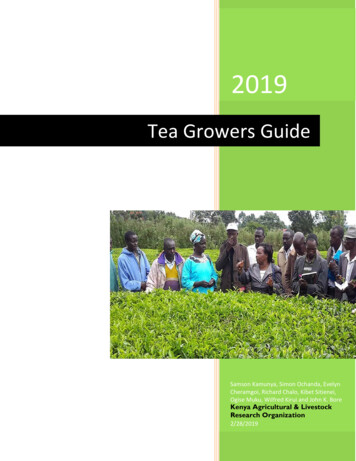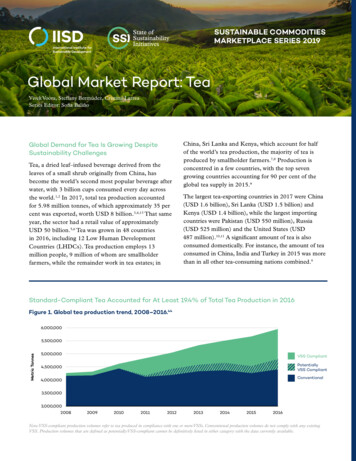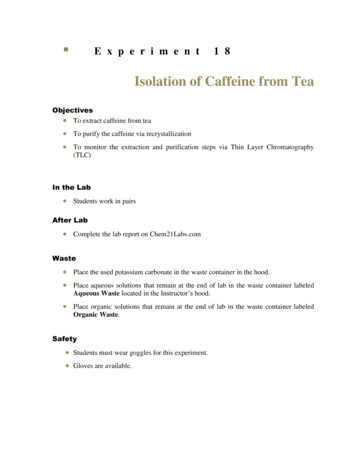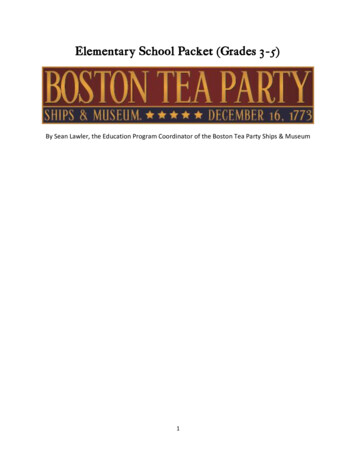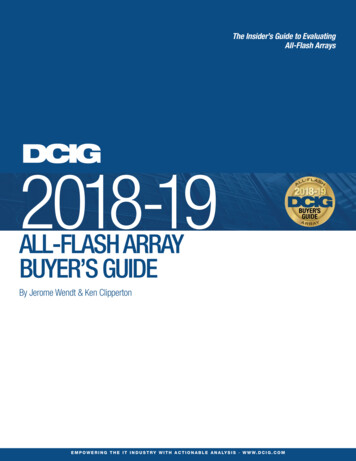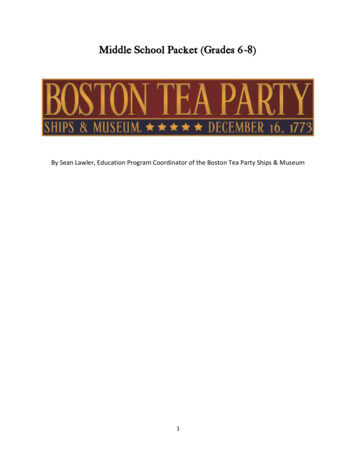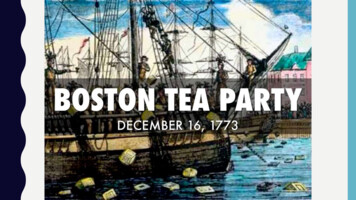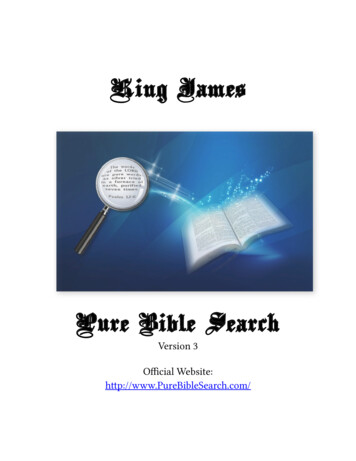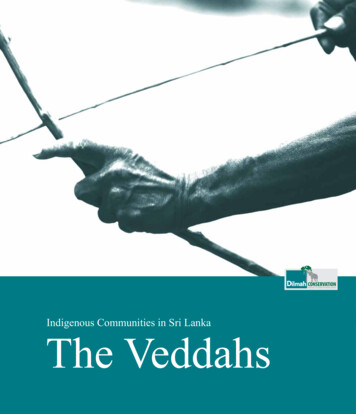
Transcription
www.dilmahconservation.orgIndigenous Communities in Sri LankaThe VeddahsDilmah ConservationThe Veddahs1
Previous image: DC2The VeddahsDilmah Conservation
SMDilmah ConservationThe Veddahs3
4The VeddahsDilmah Conservation
Declaration of Our CoreCommitment to SustainabilityDilmah owes its success to the quality of Ceylon Tea. Our business was founded therefore on an enduring connection tothe land and the communities in which we operate. We have pioneered a comprehensive commitment to minimising ourimpact on the planet, fostering respect for the environment and ensuring its protection by encouraging a harmoniouscoexistence of man and nature. We believe that conservation is ultimately about people and the future of the humanrace, that efforts in conservation have associated human well-being and poverty reduction outcomes. These core valuesallow us to meet and exceed our customers’ expectations of sustainability.Our CommitmentWe reinforce our commitment to the principle of making business a matter of human service and to the core values ofDilmah, which are embodied in the Six Pillars of Dilmah.We will strive to conduct our activities in accordance with the highest standards of corporate best practice and incompliance with all applicable local and international regulatory requirements and conventions.We recognise that conservation of the environment is an extension of our founding commitment to human service.We will assess and monitor the quality and environmental impact of its operations, services and products whilst strivingto include its supply chain partners and customers, where relevant and to the extent possible.We are committed to transparency and open communication about our environmental and social practices. We promotethe same transparency and open communication from our partners and customers.We strive to be an employer of choice by providing a safe, secure and non-discriminatory working environment for itsemployees whose rights are fully safeguarded and who can have equal opportunity to realise their full potential.We promote good relationships with all communities of which we are a part and we commit to enhance their quality oflife and opportunities whilst respecting their culture, way of life and heritage.Dilmah ConservationThe Veddahs5
Ceylon Tea Service PLCwww.dilmahconservation.orgThis publication may be produced in whole or in part and in any form foreducational or non-profit purposes without special permission from thecopyright holder, provided acknowledgement of the source is made. Nouse of this publication may be made for resale or any commercial purposewhatsoever without prior permission in writing from the copyright holder.This publication is not a complete study on the indigenous communities inSri Lanka and contains some of the information gathered during the courseof the Veddah Community Upliftment programme carried out by DilmahConservation. Additional emphasis has been given to research carried out onthe coastal Veddah community.DisclaimerThe contents and views in this publication do not necessarily reflect the views orpolicies of the copyright holder or other companies affiliated to the copyright holder.Printed and bound in SingaporeISBN: 978-955-0081-07-3Ceylon Tea Service PLCMJF Group111, Negombo RoadPeliyagodaSri LankaThe images for this publication were sourced from Darrell Bartholomeusz (DB), Alan Benson (AB), Dhanush De Costa (DD), Dimithri Cruze (DC), Bree Hutchins (BH), Namal Kamalgoda (NK), Sarath Perera (SP), M. A.Pushpakumara (PK), Devaka Seneviratne (DS), Julian Stevenson (JS), Dilhan C. Fernando (DCF), Asanka Abayakoon (AA), Spencer Manuelpillai (SP), Studio Times Ltd. (ST) and David Colin-Thome (DT).
Indigenous Communities in Sri LankaThe Veddahs
An introductionIn the same way that the evolution of man since the stone age defines us inthis 21st Century, understanding ancient tribes and their cultural, social,economic and scientific heritage has indisputable relevance in the presenttime. The symbiotic relationship that many of Sri Lanka’s ancient tribeshad with nature offers invaluable lessons for example, in sustainability. Thearchitecture, medicine, nutrition, agriculture, irrigation systems and manyother aspects of the traditional communities of Sri Lanka feature technologiesthat have been perfected over generations and which are important to scienceeven today.Dilmah Conservation began its investigation into the indigenous communitiesof Sri Lanka with two objectives. First to attempt to ease the dislocationthat many of these communities suffer as a result of the irrelevance of theirskills in the 21st Century. In seeking to do so, we have made every effortto understand and respect the cultural, social and historic context of eachof the communities that Dilmah Conservation has engaged with, in orderto nurture the identity of each as we assist them in redefining their role insociety.Secondly, we have sought to address the dearth of serious investigationand documentation of the remarkable heritage of the many indegenouscommunities in Sri Lanka. As the rapidly changing social context disruptsthe tradition of orally passing historical tales from generation to generation,we have sought to document any that could be recorded for the benefit offuture generations. The purpose here is not solely for historical record butequally that future generations of these communities might take pride in theirheritage and also benefit from it.The Culture and Indigenous Communities Programme of DilmahConservation has a socio-economic dimension which seeks to assist thecommunities in exploring opportunities in indigenous tourism, traditionalart and craft as a means of empowering themselves with dignity. I invite youto join Dilmah Conservation in its endeavour. As you read this publicationplease remember that the traditions that are recorded here are in most casesdeeply meaningful and form important elements in the complex social,cultural, environmental, historical, political and economic definition of a SriLankan in the 21st Century.Merrill J. FernandoFounder – Dilmah Conservation
AB
ForewordThe Environmental Impact Assessment (EIA) of the Accelerated MahaweliDevelopment Project which commenced in 1981 required that thecatchments of Maduru Oya and Ulhitiya be declared as a protected area forelephant conservation and catchment purposes. The prevailing legislationsin the country were scanned for the most appropriate manner to achieve thisand it clearly showed that the required protection could only be guaranteedthrough the provisions of the Fauna and Flora Protection Ordinance (FFPO)through the declaration of a National Park. Thus a decision was taken todeclare this area as a National Park (NP). This was only the beginning of asaga that was to continue in the decades to come.A national park declared under the FFPO however does not allow for privateproperty and human habitation within its precincts. Thus the fate of the‘Veddah community’ who had lived within these areas for generations wasdecided. Some of us in the wildlife EIA team felt that they should be integratedinto the wildlife sector but the authorities with decision making powers feltotherwise. The question of “should not they become part of the mainstream?”was posed and answered. The decision was taken - the community must leaveto Henanegala. The leader of the community, Thissahamy, his family andseven other families decided to stay on despite the violation of the rules of theFFPO. Thus began the new chapter of the Veddah community. They havebeen studied, been in the limelight in the past as this documentation indicate.As time passed Thissahamy continued with the assistance of Wanniya (his son)to seek due recognition for his clan. The passing away of Thissahamy resultedin Wanniya taking over the reign. Wanniya is a strong, tactful, sharp charactercompared to his father. With his determination, Wanniya was able to bringold traditions back into the mainstream. The ‘Vanniyalaththo – people of theforest’ as they call themselves (the most appropriate) and not Veddahs anymore, are today more recognised as an indigenous community in Sri Lankathan ever before. The cultural centre at Dambana is up and running. Thegovernment has pledged at various times to uplift the community needs.Despite the pledges made by many, the Vanniyalaththo has been somewhatoverlooked too. It is partly this situation that resulted in Dilmah Conservationinvolving itself to help the Vanniyalaththo or the indigenous people of thiscountry. There is much to save in their culture in the changing world. Theywere affected heavily by ‘transformations’ brought about by the dominatedcultures in the process of ‘regularisation’. The 30 year-conflict affected themseverely, as they were caught between the two conflicting parties. The distinct‘coastal Veddhas’ in the East were very much affected this way. In the past fewyears, a distinct revival or ‘recognition’ is evident through the establishmentof the ‘Varigasabha’, ‘inventorisation of villages and distribution’, etc. Thesehave been facilitated by Dilmah Conservation, and recognised and fosteredby the State whenever possible.The ‘evicted’ Veddah people have now been recognised. They have beenpermitted entry to the National Parks and have also been recruited as‘Guides’. Progressive integration of this nature helps sustain the identity ofthe community.While all these are enabling better recognition of the people and theirtraditions, modern development trends are taking its toll too. Exposureto modernisation would inevitably result in change. It would also beunacceptable to profess that they should not be benefiting from the newtechnologies – television, cellular phones, education, etc.The Vanniyalaththo are at a major crossroad in their history. It should remindus in the so-called ‘mainstream’ to ask the question “when do we recognisethem as a distinct group of persons?” (as indigenous people). Do we do thison their ‘biological traits’ or ‘their culture?’ Which do we want to preserve?The answer will lead to a critical decision that may by itself violate free choiceand humanity.This publication and the studies are thus very timely. The Vanniyalaththo areno longer just a small group confined to the areas of Dambana, Rathugala,etc. They are spread over 75 villages extending widely in the eastern part ofthe country. They have diverse ‘habits’ acquired due to their interaction withthe ‘modern’. They now have within themselves to discipline the ‘tradition’from the ‘acquired’ to take forth the true customs to the future.Professor Sarath W. KotagamaProfessor of Environmental Science, Bird Ecology and Behaviour,Conservation Biology and Ecotourism andFormer Director of Wildlife Conservation
BH
This is a blank page.
ContentsThe song of our heritageOrigin and evolution of the VeddahVeddah community in the eastThe Veddah clan VarigeKunjankalkulamLife in PatalipuramThe story of a coastal Veddah villageA Veddah village in the Trincomalee DistrictA community in the shadowsThe Veddahs of KalkudahVanniyalaththo visits the eastFirst Varigasabha in the eastChallenges faced by the coastal VeddahsDilmah ConservationOur commitment to sustainabilityAcknowledgements
14 The VeddahsDilmah ConservationDBUruvarige Vanniyalaththo, leader of the Veddah community
The song of our heritageThe anthem of the Veddah peopleEverything that is natural- god given,the sun, the moon, the wind, the treesand the beauty of the blowing wind, the wild animalwho is a part of nature itself belongs to us the Vanniyalaththothe men of the jungleFor eternity,to the day that the sun and the moon existwe will belong to the yakka tribeOur forearms possess the strength of a steady rockour minds are filled with beautythat can be compared to the serenity of the jungleour hearts contain the rhythm of the running waterwe are the men of the jungle.*Yakka is one of the two tribes that are said to have inhabited the country at the time whenPrince Vijeya landed somewhere between 5th and 6th century BC.(The Veddah anthem was composed by Dambane Gunewardena,who has the distinction of being the first indigenous person to have gained entrance to a university in Sri Lanka)Dilmah ConservationThe Veddahs 15
Veddahs of Mahiyangana16 The VeddahsDilmah Conservation
PKDilmah ConservationThe Veddahs 17
Origin and evolution of the Veddah‘Every part of this soil is sacred in the estimation of my people. Everyhillside, every valley, every plain and grove, has been hallowed by somesad or happy event in days long vanished. Even the rocks, which seem tobe dumb and dead as the swelter in the sun along the silent shore, thrillwith memories of stirring events connected with the lives of my people, andthe very dust upon which you now stand responds more lovingly to theirfootsteps than yours, because it is rich with the blood of our ancestors, andour bare feet are conscious of the sympathetic touch.Our departed braves, fond mothers, glad, happy hearted maidens, and eventhe little children who lived here and rejoiced here for a brief season, will lovethese sombre solitudes and at eventide they greet shadowy returning spirits’,Chief Seattle the leader of the Red Indians said as far back as 1854.These words hold true to this day. The indigenous community of any landwould share these very thoughts that Chief Seattle intended to share in theface of colonisation and integration. It is in the face of the very threat ofintegration that today, we fear the loss and recognise the uniqueness of ourvery own ‘Fathers of the Land’- the Veddahs of Sri Lanka.The term ‘Veddah’ finds its roots from the Sanskrit word ‘Vyadha’. Themeaning of which is hunter with a bow and arrow. The pure Veddahs, unlikethe Sinhalese who speak an Indo-Aryan language and claim Aryan descent,are related to the Austro-Asiatic people found scattered today in many partsof southern Asia.They are also referred to as ‘Vanniyalaththo’ or forest dwellers. This wordis often misinterpreted to represent a name of a single individual or a tribeamongst the Veddahs, but there is solid reason to believe, that the term wascoined due to the very fact that the members of the indigenous communityof Sri Lanka, were and still are in actual fact, forest dwellers. Living withinthe beauty of nature, finding their salvation, their livelihood, their love,affection and continuation within the realms of Mother Nature. As KahlilGibran would say to them ‘The sun is the mother of the earth and gives it itsnourishment of heat; it never leaves the universe at night until it has put theearth to sleep to the song of the sea and the hymn of the birds and brooks. Andthis earth is the mother of trees and flowers. It produces them, nurses them, andweans them. The trees and flowers become kind mothers to their great fruits andseeds. And the mother, the prototype of all existence, is the eternal spirit, full ofbeauty and love.’The Veddahs of Sri Lanka, descend from a direct line of Sri Lanka’s Neolithiccommunity. It is estimated that their origins lie as far back as 16,000 BC.However, according to modern scientific research, there is strong opinion tobelieve that since 125,000 BC there were settlements and civilisations within SriLanka. The lineage of the current Veddahs however, could be ascertained to theera between 18,000 BC and 15,000 BC.The Mahawamsa, the main chronicle that recorded the history of this nationhowever opines otherwise. According to it, the Veddah lineage is directlyconnected to the father of the Sinhala race, Vijaya. Prince Vijaya (5 BC - 6BC) who later went on to become the first king of Sri Lanka, met Kuveni onthe shores of ‘Thambapanni’. Kuveni was the queen of the Yakka’s, one of thetwo tribes, the other being the Nagas that had settlements in Sri Lanka. Vijaya,fell in love with the queen and they had two children, a girl and a boy. Themarriage was short-lived, as Vijaya, by then king of the island, left Kuveni for aPandyan princess. The children had then, according to the chronicle, departedto the valleys of the Ratnapura District where they had multiplied giving rise tothe Veddahs of today. There is strong academic opinion in favour of the abovenarration and anthropologists such as Seligmann as far back as, 1911 believedthat there were similarities between the genetics of the Yakkas and modern dayVeddahs.Nandadeva Wijesekara, author of Veddas in Transition (1964), believes that theword Sabaragamuwa, the province in which the Ratnapura District is situatedis derived from the dwelling of the Veddahs. ‘Sabaras’ is interpreted as ‘forestUru Varige Thissahamy, late leader of the Veddah community and father of the present leader, is credited as the person who spearheaded Veddah revival in Sri Lanka18 The VeddahsOrigin and evolution of the Veddah
dwellers’, akin to the Vanniyalaththo. Many places situated in the environsof the District to this day bear names such as ‘Vedhi Gala’, ‘Vedha Ala’, and‘Vedi Kanda’, bearing testimony to this school of academic opinion.Dr. S.V. Deraniyagala, former Director General of Archaeology in Sri Lankahowever goes a step further. He points out in his research work titled The earlyman and the rise of civilization in Sri Lanka: Archaeological evidence (1992)that the genetic continuum from at least 18,000 BC at Batadombalena toBelilena at 16,000 BC and to the Bellan Bandi Palassa at 6,500 BC connectsto the modern Veddah population. He opines that in actual fact, the Veddahscould find a common ancestor in the form of the ‘Balangoda man’. All thesesites where human remains have been found were subject to detailed scientificstudy. They are considered to yield the earliest evidence of the anatomicallymodern man in South Asia. ‘These anatomically modern prehistoric humansin Sri Lanka are referred to as Balangoda Man in popular parlance (derivedfrom his being responsible for the Mesolithic ’Balangoda Culture’ first definedin sites near Balangoda). He stood at an estimated height of 174 cm for malesand 166 cm for females in certain samples, which is considerably higher whencompared with the genetics of the present-day population in Sri Lanka. Thebones are robust, with thick skull-bones, prominent brow-ridges, depressedwide noses, heavy jaws and short necks. The teeth are conspicuously large.These traits have survived in varying degrees among the Veddahs and certainSinhalese groups, thus pointing to Balangoda Man as being the commonancestor.’SPWithin the course of their evolution, the original community spread across thecountry setting up home in rural parts of the Island. Dambana, is consideredthe capital of the Veddah community and some folk moved and integratedwith society in areas in North Central and Uva Provinces.Origin and evolution of the VeddahThe Veddahs 19
Though much of their original practicesand grandeur have been compromised tothis day, many find their distinct culture andpractices fascinatingThere is also a distinct line of these indigenous inhabitants found within theeast coast of Sri Lanka. Though much of their original practices and grandeurhave been compromised to this day, many find their distinct culture andpractices fascinating.The Veddah lifestyle is intertwined with forest ecology. The restrictionsthat have been put forth internally due to the scarcity of resources and theirnomadic lifestyle have influenced the tribes being split into small groups.Each group comprises a nuclear family or a few extended families. These clansdwell within clearly demarcated boundaries and territories. This very fact hastacitly played a pivotal role in forming a unique but sustainable lifestyle forthese ‘forest dwellers’. The nature of hunting, gathering of rations, chenacultivation and the size of the individual group, have direct bearing to thedivision of labour among each individual group. The Veddahs seldom haveindividual belongings; this in turn facilitates their mobility and harnessestheir freedom. Thus inevitably, some clans hold distinct advantage due tothe fact that the clans that have settled down have access to more naturalresources and good hunting grounds.The ritual structure of the Veddah society, also finds it’s bearings from natureitself. The affiliations of clans, tribes and the Veddah community as a whole,have towards the transcendental, in which they believe they are being lookedafter by some spirit who is a relative, animal or plant, the worship of treesand rocks, which are located at some strategic location important to theclan, charms and songs that are meant to invoke blessings, and the ritualisticveneration of the supernatural at the beginning and end of cultivation, pointstowards the Veddah’s distinct relationship with forest ecology itself.Despite colonisation and resettlements of Veddahs, the chieftains haveremained strong in their resolve; Varige Wanniya, the chieftain of the Veddah’saddressing the United Nations working group on Indigenous people in 1996was very clear ‘We want to survive not only as a people but also as a culture’,he said. This was in the backdrop of the Maduru Oya reserve being takenout of the hands of the Veddahs and the criminality that was prescribed tothe killing of beasts and the shredding of forests. ’Our relationship with ourenvironment is changing. We were the custodians of the jungle throughout thegenerations. Now the jungle is no longer ours and we do not feel responsiblefor its maintenance. A ‘grab and run’ philosophy has developed. We sneakinside, kill what we can get and then run outside again. We would not do thatbefore. We were taught not to kill an animal drinking water, because we allneed to drink water. We would not kill a pregnant mother; a deer, a sambhuror any other pregnant animal. We would not kill a four-legged mother givingmilk to her young ones. The very land we, the Vanniyalaththo, shared withother beings (aththo) is also shared by our ancestral forefathers, gods andgoddesses and forest spirits. We are now alienated from them.’This underscores the threat that modern civilisation presents to the indigenouscommunity. They have been dwindling in numbers due to integration withthe Sinhalese and Tamil community and to make matters worse, there is theissue of direct governmental intervention either by way of law or by way ofresettlements.Uru Varige Vanniyalaththo, leader of the Veddah community during his Dilmah Conservation sponsored historic visit to the Eastern Province20 The VeddahsOrigin and evolution of the Veddah
AAOrigin and evolution of the VeddahThe Veddahs 21
Veddah community in the eastThe Veddah community in the east, often referred to as ‘Muhudu Veddah’or ‘Veddahs of the sea’, reside mainly in the Districts of Trincomalee andBatticaloa. Despite being intrinsically connected to the ‘original inhabitantsof the land’, this community bears very little resemblance to the originalVeddahs. The word Veddah is often associated with a bare chested man,carrying a weapon on his shoulder with his hair tied behind his head. Thisgeneralised description does not fit the present day Veddahs of the east. Theyseldom bare resemblance to the prototype of the indigenous Lankan.The remake of the Veddah in the eastern part of the island can be attributedto the socio-political reinvigoration that has swept across the country. Manyof the Veddahs have married into native Tamil families and thereon haveevolved into the normal way of life of the community.The only recognition of the eastern Veddah, as being distinctly indigenous,is a purely theoretical one. The United Nations definition on what anindigenous population is, was first formulated in 1972 and was subject toamendments. The original definition reads ‘Indigenous populations arecomposed of the existing descendants of the peoples who inhabited thepresent territory of a country wholly or partially at the time when persons ofa different culture or ethnic origin arrived there from other parts of the world,overcame them, by conquest, settlement or other means, reduced them to22 The Veddahsa non-dominant or colonial condition; who today live more in conformitywith their particular social, economic and cultural customs and traditionsthan with the institutions of the country of which they now form part, undera state structure which incorporates mainly national, social and culturalcharacteristics of other segments of the population which are predominant.’Thus the Veddahs of the east would find themselves within the parameters ofthe above definition. The date of their first arrival on the coast and of theirsubsequent inter-marriage with Tamils is uncertain. According to Seligmann,Veddahs have been within the neighborhoods of the sites they now occupysince the beginning of the coastal Veddahs, but the Veddahs themselves havea belief that they migrated from the inlands. Robert Knox does not mentionthem, but Hugh Neville considers that they came from Sabaragamuwa(Sufferagam), being driven from their native Sabaragamuwa during the 17thcentury.There is strong academic opinion to refute Neville’s claim. The oldergeneration of Veddahs, despite not being able to give a clear date or place oftheir arrival in the coast, were of the opinion that their forefathers migratedto the east of the country from a place with the name of ‘Gala’ (stone). Takingthe above into consideration, we can assume that these Veddahs migratedfrom either Dimbulagala or Nilgala, habitats situated close to the BatticaloaVeddah community in the east
DCAccording to Seligmann, Veddahs havebeen within the neighborhoods of the sitesthey now occupy since the beginning of thecoastal Veddahs.District. Seligmann’s research suggested that the coastal Veddahs and theVeddahs from Dimbulagala share certain similarities, including affiliation tothe Aembalawa clan and this is used as a tool to evidence the relationshipbetween the Veddahs of Dimbulagala and the coastal Veddahs, therebyrefuting the claim that they were infact driven away from the SabaragamuwaProvince in the 17th century.Seligmann writes in his acclaimed book The Veddas (1911) that ‘The CoastVeddahs do not know when they came or how they came, but they say that longago their ancestors came from the Gala, far beyond the hills to the west. Theyalso sometimes say they came from Kukulu-gammaeda and spread out alongthe Coast. Some say this is Kukulugam near Verukal; others suppose it to besomewhere far away.’The Veddahs of the east coast, reside along the Mahaweli River, the longestof the four main rivers in the country. The areas around the river, namelyDalukana, Yakkure, Dimbulagala, Bintanne etc have been main habitatsof the indigenous community. There were two distinct Veddah clans livingon the north and south of the river. According to a renowned publicservant and former Chief Secretary of North and Eastern Province, G.Krishnamurthi, these two clans meet at a certain time of the year, duringmigration; the southern clan walking to the north of the river and vice versa.During this meeting, the two clans spend a few days together feasting. Thesemeetings of the two clans and the resulting feasts have been mentioned by aPortuguese historian named Queyrose. According to Queyrose, the two clansmeet once every three months, at four different areas along the strip. Themeeting involves hundreds of Veddahs and the males use this meeting as anopportunity to hunt for prey; the meeting culminates in the feast describedby Krishnamurthi many years later.Some coastal Veddahs have no distinct features, that would immediatelydistinguish them from village Tamils. They speak the local language and do notpossess any knowledge of the Veddah language. The names Poonamma, Vasanthiall but speaks of their natural integration with the local Tamil community.Veddah community in the eastThe folk that we consider as coastal Veddahs also dislike being identified withthe Indigenous people. This can be mainly attributed to the caste hierarchyprevalent in the eastern and northern region of the country. The Tamils lay a lotof emphasis on the caste of an individual and to this day certain practices whichdiscriminate individuals according to their caste are prevalent. The Veddahcommunity is considered the lowest of the regional castes and is shunned bypersons of higher castes in the region. As a result, there has been a tremendousloss of heritage and roots for the coastal Veddah people. Tragically, the term‘Veddan’ which is Tamil for Veddah is now used in the region only to rebuke astubborn or naughty child or in a derogatory sense.The Veddahs 23
Recorded history suggests that this Veddah chief was a man-servant, of a thenpowerful state official named Rajapakshe. He supplied him with constantofferings of traditional meat and honey and was considered to be loyal to thestate official. Mudliyar Rajapakshe, as he was known was impressed with thebenevolence with which he was regarded by the Veddah chief and ensuredPuliyans marriage to Kandi, a local Veddah girl. There is also mention ofanother Veddah chief by the name of Karadiyan. It is said that the dutyof this chief and his clan was to help with the construction of buildings inthe area. There is also evidence to suggest that the Veddahs in the area wereinvolved with the growing of paddy and other agriculture related industries.Hugh Neville’s discovery, the Nadukadu Record goes on to state that whenMudliyar Rajapakshe visits Batticaloa, he brings with him two Veddahs akinto modern day bodyguards. The reason was his fear of attack from anotherVeddah clan, which resided in an area then known as Palwekam. There is alsoa record of the visit of King Senarath to the eastern coast. During this visitit is said that the Vegoda Veddah clan played the role of ‘obedient servant’ tothe king. There is good reason to believe that the Vegoda Veddah clan andthe clan that resided in Palwekam, according to Hugh Neville, are one andthe same.During the
Dilmah owes its success to the quality of Ceylon Tea. Our business was founded therefore on an enduring connection to the land and the communities in which we operate. We have pioneered a comprehensive commitment to minimising our impact on the planet, fostering respect for the environment an
